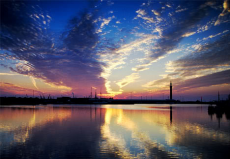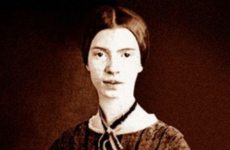
Email: ZYVC057@live.rhul.ac.uk
Total Article : 213
About Me:I'm a graduate student studying International Criminal Law and first started writing for King's News almost 4 years ago! My hobbies include reading, travelling and charity work. I cover many categories but my favourite articles to write are about mysteries of the ancient world, interesting places to visit, the Italian language and animals!

There is another sky – Emily Dickinson
There is another sky,
Ever serene and fair,
And there is another sunshine,
Though it be darkness there;
Never mind faded forests, Austin,
Never mind silent fields -
Here is a little forest,
Whose leaf is ever green;
Here is a brighter garden,
Where not a frost has been;
In its unfading flowers
I hear the bright bee hum:
Prithee, my brother,
Into my garden come!
ANALYSIS
‘There is another sky’ is perhaps one of Emily Dickinson’s most famous poems. The poem is addressed to Emily’s brother Austin and, judging by the context of the letter which accompanied it, it is plausible to say that in the poem Emily tries to persuade her brother to return from Boston to Amherst. If we think of the poem in such way, the main focus becomes the place. Amherst is a geographical location like many others yet in the poem it acquires a more celestial depiction. Indeed whilst places can change, Amherst is described as a heavenly location which always stays the same. What Emily is most probably hinting at here is that your home will always remain your home no matter what, and as such will always be special to you. She reinforces this idea by adopting terms which evoke perpetual features, for example ‘whose leaf is ever green’ and ‘unfading flowers’. The simple fact the first line of the poem is ‘there is another sky’ indicates that the subject in discussion is not something that is ‘here’ but something heavenly. Later on in the poem the speaker states ‘here is a brighter green’ where ‘here’ indicates a more mundane location. Emily utilises this mixture of celestial and heavenly features as a rhetorical device to reinforce the theme of perception and senses, connecting the two world through the simple words ‘there’ and ‘here’.
This poem about finding such a wonderful garden does not have an explicit meaning – one could read it as talking about a person whereas another could identify the sky as another place - and, in my opinion, this is the true beauty of the poem, you can interpret it as you wish.

ABOUT THE AUTHOR
Emily Elizabeth Dickinson was born in 1830 in Amherst, Massachusetts. Emily was known for living quite an introverted life. She was thought of as eccentric by the local community due to her regular white clothing and her refusal to greet guests. Later on in her life she spent most of her time closed in her room, therefore the majority of acquaintances Emily had were kept via letters.
During her lifetime, Emily Dickenson saw less than a dozen of her poems published out of almost 1,800! Also, the few poems that did make it were usually heavily edited before then being published in order to adapt them to the literary style of the time. In fact only after Emily’s death in 1880, her sister Lavinia found more of Emily’s poems and they finally began to be circulated and acknowledged for their beauty. Emily’s poems are quite unique: they typically have short lines whilst using alternative punctuation and capitalisation. The recurring themes of her poems are centred around death and more sombre aspects of humanity which leave Emily Dickenson’s readers pensive and intrigued after each and every verse.
Image 1: https://karamriver.files.wordpress.com/2009/11/1-1.jpg
Image 2: http://www.poetryfoundation.org/uploads/authors/emily-dickinson/448x/emily-dickinson.jpg

0 Comment:
Be the first one to comment on this article.